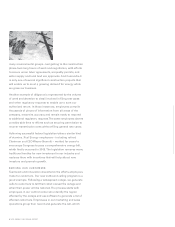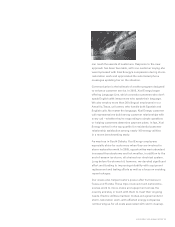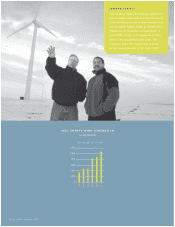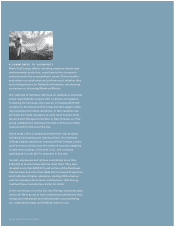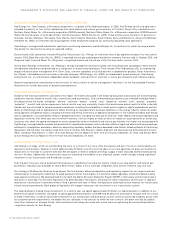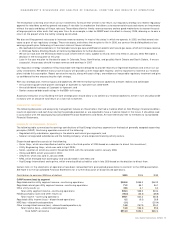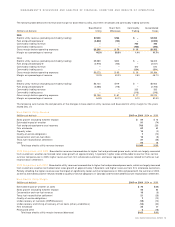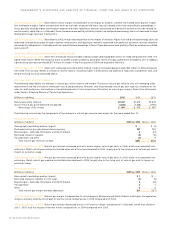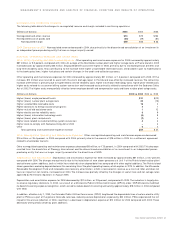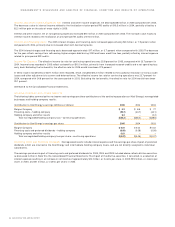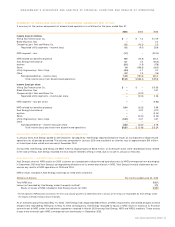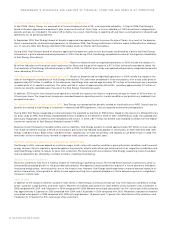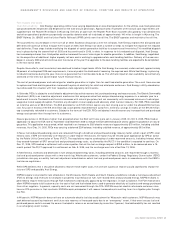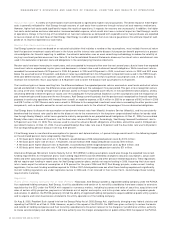Xcel Energy 2005 Annual Report Download - page 18
Download and view the complete annual report
Please find page 18 of the 2005 Xcel Energy annual report below. You can navigate through the pages in the report by either clicking on the pages listed below, or by using the keyword search tool below to find specific information within the annual report.
BUSINESS SEGMENTS AND ORGANIZATIONAL OVERVIEW
Xcel Energy Inc. (Xcel Energy), a Minnesota corporation, is a public utility holding company. In 2005, Xcel Energy continuing operations
included the activity of four utility subsidiaries that serve electric and natural gas customers in 10 states. These utility subsidiaries are
Northern States Power Co., a Minnesota corporation (NSP-Minnesota); Northern States Power Co., a Wisconsin corporation (NSP-Wisconsin);
Public Service Company of Colorado (PSCo); and Southwestern Public Service Co. (SPS). These utilities serve customers in portions of
Colorado, Kansas, Michigan, Minnesota, New Mexico, North Dakota, Oklahoma, South Dakota, Texas and Wisconsin. Along with WestGas
InterState Inc. (WGI), an interstate natural gas pipeline, these companies comprise our continuing regulated utility operations.
Xcel Energy’s nonregulated subsidiaries reported in continuing operations include Eloigne Co. (investments in rental housing projects
that qualify for low-income housing tax reported credits).
Discontinued utility operations include Viking Gas Transmission Co. (Viking), an interstate natural gas pipeline company that was sold in
January 2003; Black Mountain Gas Co. (BMG), a regulated natural gas and propane distribution company that was sold in October 2003; and
Cheyenne Light, Fuel and Power Co. (Cheyenne), a regulated electric and natural gas utility that was sold in January 2005.
During 2003, Planergy International, Inc. (Planergy), (energy management solutions) closed, with final dissolution completed in 2004. Several
nonregulated subsidiaries are presented as a component of discontinued operations. They include Utility Engineering (UE), an engineering,
design and construction management firm; Quixx Corp., a former subsidiary of UE that partners in cogeneration projects; Seren Innovations,
Inc. (Seren), a broadband communications services company; NRG Energy, Inc. (NRG), an independent power producer; Xcel Energy
International, Inc., an international independent power producer; and e prime inc. (e prime), a natural gas marketing and trading company.
Discontinued operations classifications are the result of sales or plans to sell by management. See Note 2 to the Consolidated Financial
Statements for further discussion of discontinued operations.
FORWARD-LOOKING STATEMENTS
Except for the historical statements contained in this report, the matters discussed in the following discussion and analysis are forward-looking
statements that are subject to certain risks, uncertainties and assumptions. Such forward-looking statements are intended to be identified in
this document by the words “ anticipate,” “ believe,” “estimate,” “expect,” “ intend,” “ may,” “objective,” “outlook,” “ plan,” “ project,” “ possible,”
“ potential,” “ should” and similar expressions. Actual results may vary materially. Factors that could cause actual results to differ materially
include, but are not limited to: general economic conditions, including the availability of credit and its impact on capital expenditures and the
ability of Xcel Energy and its subsidiaries to obtain financing on favorable terms; business conditions in the energy industry; actions of credit
rating agencies; competitive factors, including the extent and timing of the entry of additional competition in the markets served by Xcel Energy
and its subsidiaries; unusual weather; effects of geopolitical events, including war and acts of terrorism; state, federal and foreign legislative and
regulatory initiatives that affect cost and investment recovery, have an impact on rates or have an impact on asset operation or ownership;
structures that affect the speed and degree to which competition enters the electric and natural gas markets; the higher risk associated with
Xcel Energy’s nonregulated businesses compared with its regulated businesses; costs and other effects of legal and administrative proceedings,
settlements, investigations and claims; actions of accounting regulatory bodies; the items described under Factors Affecting Results of Continuing
Operations; and the other risk factors listed from time to time by Xcel Energy in reports filed with the Securities and Exchange Commission
(SEC), including “ Risk Factors” in Item 1A of Xcel Energy’s Annual Report on Form 10-K for the year ended Dec. 31, 2005, and Exhibit 99.01
to Xcel Energy’s Annual Report on Form 10-K for the year ended Dec. 31, 2005.
MANAGEMENT’S STRATEGIC PLAN
Xcel Energy’s strategy, which we call Building the Core, is to invest in our core utility businesses and earn the return authorized by our
regulatory commissions. We plan to invest approximately $7 billion over the next five years in our core operations to grow our business in
response to an increase in customer demand. We anticipate a need for additional energy supply in both Colorado and Minnesota during
the next 15 years. Additionally, we continue to focus on enhancing the reliability of our electrical system, which includes making significant
investment in our transmission and distribution systems.
Over the past five years, we’ve divested 10 businesses or subsidiaries that were not closely linked to our core electric and natural gas
businesses, realizing cash proceeds of nearly $440 million. Today, we’re a vertically integrated utility and we intend to stay that way.
Our strategy of Building the Core has three phases. The first phase is obtaining legislative and regulatory support for our large investment
initiatives prior to making the investment. To avoid excessive risk for the company, it is critical to reduce regulatory uncertainty before making
large capital investments. We accomplished this for both the Metro Emission Reduction Project (MERP) in Minnesota and the Comanche 3
coal plant in Colorado. Transmission legislation has been passed in Minnesota, allowing that state’s regulatory commission to approve
recovery for transmission investments without filing a general rate case. In Texas, the legislature authorized annual recovery for transmission
infrastructure improvements. Both pieces of legislation will support necessary new investment in our transmission system.
The second phase is making those investments. In a normal year, we spend approximately $1 billion on capital projects. In addition to our
base level of capital investment, we expect to spend approximately $1 billion on MERP and $1 billion on Comanche 3 through 2010. As a result
of these investments, as well as continued investments in our transmission and distribution system to ensure continued reliability and to meet
our customer growth requirements, we expect that our rate base, or the amount on which we earn a return, will grow annually by slightly
more than 4 percent on average. Finally, such investments will always be made with a clear focus on optimizing environmental protection,
a significant priority for Xcel Energy.
16 XCEL ENERGY 2005 ANNUAL REPORT
MANAGEMENT’S DISCUSSION AND ANALYSIS OF FINANCIAL CONDITION AND RESULTS OF OPERATIONS




